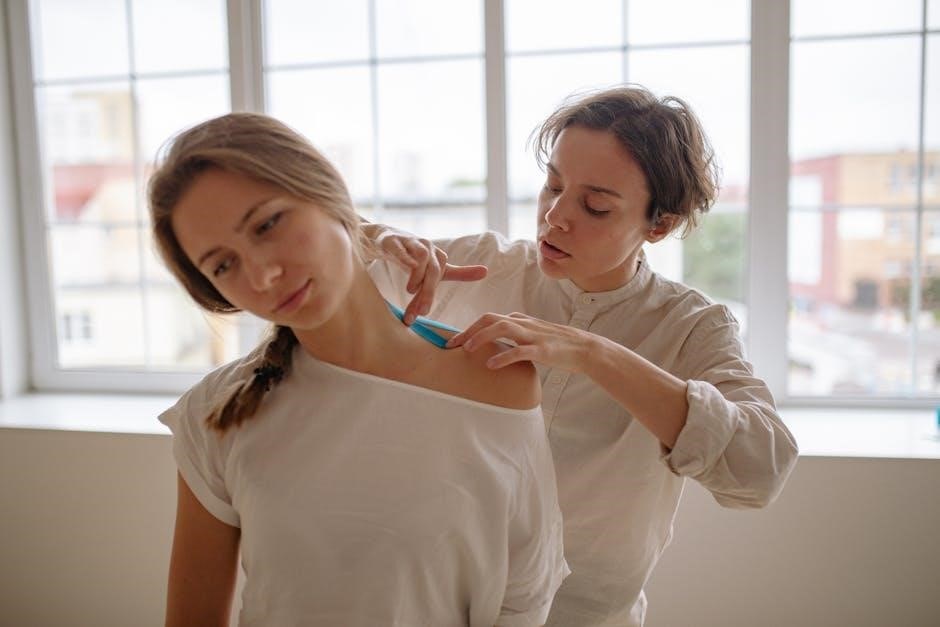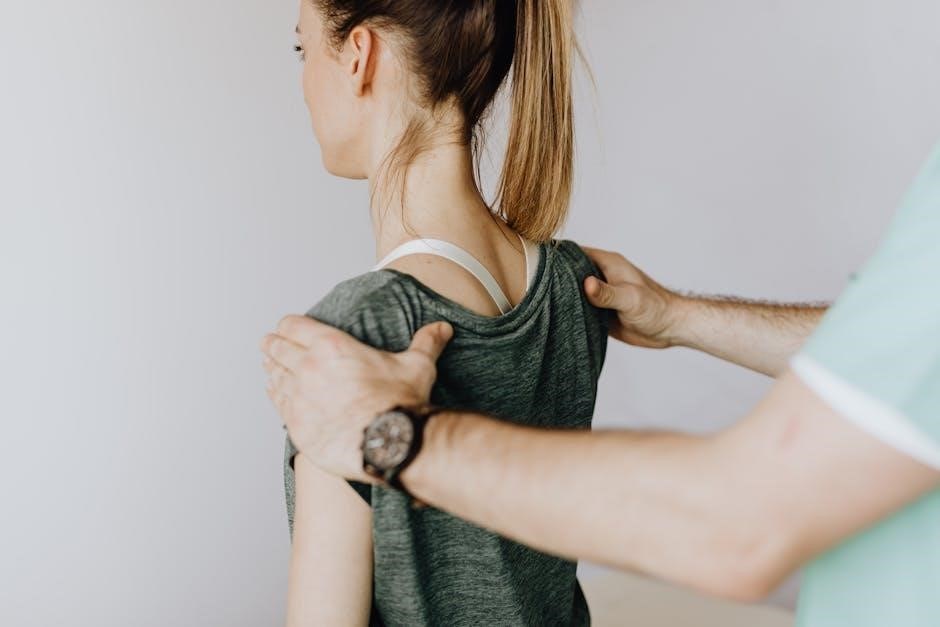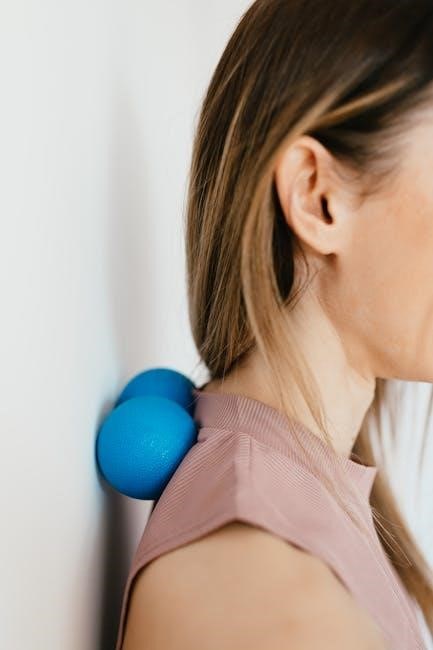A structured rehabilitation protocol is essential for managing shoulder dislocations, minimizing complications, and restoring shoulder function. This approach typically involves a phased program, focusing on pain relief, range of motion exercises, and gradual strengthening to ensure optimal recovery and prevent future injuries.
1.1. Understanding Shoulder Dislocation
Shoulder dislocation occurs when the humerus bone slips out of the shoulder socket, causing pain and instability. It can be anterior (forward) or posterior (backward), with anterior being more common. Posterior dislocations account for about 25% of cases and are often caused by specific injuries or conditions. Understanding the type and severity of the dislocation is crucial for developing an effective rehabilitation plan. Symptoms include pain, limited movement, and a visible deformity. Accurate diagnosis and appropriate treatment are essential to restore shoulder function and prevent recurring dislocations. This section provides a foundation for understanding the injury before diving into the rehabilitation process.
1.2. Importance of a Structured Rehabilitation Plan
A structured rehabilitation plan is vital for effectively managing shoulder dislocations, ensuring a safe and progressive return to normal activities. This plan helps minimize pain, restore range of motion, and strengthen the shoulder muscles, particularly the rotator cuff, which is crucial for stability. Without a structured approach, there is a higher risk of recurring dislocations and chronic instability. The plan also addresses proprioception, improving the body’s awareness of joint position, which is essential for preventing future injuries. By following a phased protocol, patients can achieve optimal recovery and regain functional ability, whether for daily activities or sports participation. Consistency and adherence are key to success.

Phase 1: Pain Relief and Range of Motion
The initial phase focuses on alleviating pain and restoring shoulder mobility through gentle exercises and ice therapy, ensuring a foundation for further recovery and strengthening.
2.1. Goals of Phase 1
The primary objectives of Phase 1 are to reduce pain, inflammation, and muscle spasms, while gradually restoring the shoulder’s range of motion. This phase also aims to prevent stiffness and promote early mobilization, ensuring the shoulder joint remains functional. By addressing these goals, Phase 1 lays the groundwork for subsequent strengthening and rehabilitation phases, which are crucial for achieving full recovery and preventing future dislocations. Proper adherence to this phase’s exercises and therapies is essential for a smooth transition to more advanced stages of the rehabilitation process.
2.2. Exercises for Phase 1
Phase 1 focuses on gentle exercises to restore range of motion and reduce stiffness without exacerbating the injury. Common exercises include pendulum swings, passive external rotations using a stick or assistance, and wall slides. These activities help improve flexibility and mobility while minimizing pain. Patients are also encouraged to perform isometric exercises to maintain muscle activation without joint movement. Ice therapy is often incorporated to reduce inflammation. These exercises are typically performed 2-3 times daily, with gradual progression based on pain tolerance and improvement. The emphasis is on controlled movements to avoid further damage and ensure a stable foundation for the next phase of rehabilitation. Consistency is key to achieving optimal results.
2.3. Duration of Phase 1
The duration of Phase 1 typically lasts 2-4 weeks, depending on the severity of the dislocation and individual recovery progress. This phase focuses on pain relief and restoring basic range of motion. During this time, patients are advised to avoid any movements that could exacerbate the injury. The primary goals are to reduce inflammation, improve joint mobility, and strengthen the surrounding muscles without overloading the shoulder. Progression to Phase 2 is determined by the patient’s ability to perform exercises pain-free and achieve near-normal range of motion. Consistent adherence to the prescribed exercises and therapy interventions is crucial for a smooth transition to the next phase. Regular assessments by a physiotherapist ensure the shoulder is ready for more advanced exercises.

Phase 2: Strengthening
Phase 2 focuses on strengthening the rotator cuff and scapular muscles to enhance shoulder stability and endurance, preparing for more dynamic movements and reducing the risk of re-injury.
3.1. Goals of Phase 2
The primary goals of Phase 2 in shoulder dislocation rehabilitation are to restore rotator cuff strength, improve scapular stability, and enhance overall shoulder function. This phase aims to gradually increase muscle endurance and prepare the shoulder for more dynamic movements. Strengthening exercises focus on improving the activation and coordination of key muscles, reducing the risk of recurring dislocations. Additionally, Phase 2 emphasizes restoring proper movement patterns and addressing any muscle imbalances. By achieving these goals, patients can progress toward more advanced activities while maintaining joint stability and reducing pain. This phase is critical for building a foundation for long-term recovery and functional return.
3.2. Exercises for Phase 2
In Phase 2 of shoulder dislocation rehabilitation, exercises focus on strengthening the rotator cuff and scapular muscles while improving joint stability. Common exercises include supraspinatus strengthening using light weights or resistance bands, scapular wall slides to enhance scapular mobility, and internal and external rotation exercises with light dumbbells or a resistance band. Patients also perform lateral raises and forward elevations to restore muscle balance. These exercises are done with controlled movements to avoid strain. Progression to more dynamic exercises, such as resisted rows and scapular push-ups, is guided by pain-free range and strength improvement. Proper form and adherence to prescribed repetitions are critical to ensure safe and effective recovery.

Phase 3: Advanced Strengthening and Proprioception
This phase focuses on enhancing strength, improving joint stability, and restoring proprioception. Exercises progress to dynamic movements, incorporating resistance and balance challenges to prepare for functional activities.
4.1. Goals of Phase 3
The primary objectives of Phase 3 are to enhance muscular strength, improve joint stability, and restore proprioception. This phase aims to progress patients from basic exercises to more dynamic movements, ensuring the shoulder can handle increased loads and functional demands. Key goals include restoring dynamic stability, improving neuromuscular control, and preparing the shoulder for advanced activities. By focusing on strength and proprioception, Phase 3 lays the foundation for returning to sports or high-level tasks. Patients should demonstrate improved resistance to dislocation and better overall shoulder function by the end of this phase. Achieving these goals ensures a smoother transition to the next rehabilitation stages.
4.2. Exercises for Phase 3
Phase 3 focuses on advanced strengthening and proprioceptive exercises to enhance shoulder stability and function. Key exercises include resistance band rotations to target the rotator cuff, weighted shoulder stabilizations to improve dynamic control, and plyometric exercises to restore power and reactive strength. Patients also perform dynamic balance drills, such as single-arm wall slides, to challenge proprioception. Additionally, functional movements like overhead reaches and controlled external rotations with weights are introduced. These exercises are tailored to the individual’s progress and sport-specific demands, ensuring a smooth transition to higher-level activities while minimizing the risk of re-injury. Proper form and technique are emphasized throughout.

Phase 4: Return to Activity

This phase focuses on gradual progression to normal activities and sports, ensuring the shoulder is stable, strong, and ready for full functional demands.
5.1. Goals of Phase 4
The primary goals of Phase 4 are to restore full range of motion, achieve normal strength, and ensure joint stability. This phase aims to minimize the risk of recurrent dislocation while progressing toward functional movements. Patients work on advanced strengthening exercises and sport-specific activities to prepare for a safe return to their previous level of activity. Additionally, improving proprioception and dynamic stability is crucial to prevent future injuries. The focus is on restoring confidence and ensuring the shoulder can withstand the demands of daily life or athletic endeavors. Proper scapular mechanics and balanced muscle strength are emphasized to support long-term recovery and function.
5.2. Exercises for Phase 4
In Phase 4, exercises focus on advanced strengthening, functional movements, and sport-specific activities. Plyometric exercises, such as medicine ball throws and plyometric push-ups, are introduced to improve power and dynamic stability. Resistance band exercises for external and internal rotation are continued with higher resistance. Dynamic stability drills, like single-arm balance exercises, are incorporated to enhance proprioception. Sport-specific drills, such as throwing or overhead movements, are tailored to the patient’s activities. Agility and reaction training are also added to mimic real-life or athletic demands. The emphasis is on progressing to full functional movements while maintaining proper form and control to prevent overloading the shoulder joint.
5.3. Criteria for Returning to Sport
The decision to return to sport is based on achieving specific clinical and functional milestones. Patients must exhibit full, pain-free range of motion and strength equivalent to the uninjured shoulder. Functional tests, such as single-arm stability and dynamic control during overhead movements, must be passed. The athlete must also demonstrate proper proprioception and neuromuscular control to prevent recurrent instability. A final clearance from a healthcare provider is required, ensuring the shoulder is stable and ready for sport-specific demands. Adequate progression through the rehabilitation phases and a structured return-to-play program are essential to minimize the risk of re-injury.

Phase 5: Long-Term Maintenance
This phase focuses on maintaining shoulder strength, flexibility, and proper posture through ongoing exercises and lifestyle adjustments to prevent future dislocations.
6.1. Goals of Phase 5
The primary objectives of Phase 5 are to prevent recurrent dislocations, optimize shoulder function, and promote long-term independence. This phase aims to enhance strength, flexibility, and proprioception while ensuring proper posture and biomechanics. Patients should achieve a stable shoulder joint capable of withstanding daily activities and sports. Additionally, the focus is on maintaining a consistent exercise routine to prevent muscle atrophy and improve joint mobility. Education on proper lifting techniques and movement patterns is emphasized to reduce injury risk. By the end of this phase, individuals should demonstrate improved overall shoulder health and confidence in performing tasks without fear of dislocation. Adherence to a lifelong maintenance program is crucial.
6.2. Exercises for Phase 5
Phase 5 focuses on advanced exercises to maintain shoulder stability and strength. Dynamic shoulder stabilization drills, such as resisted shoulder rotations and plyometric exercises, are introduced to challenge proprioception. High-level scapular strengthening exercises, like single-arm push-ups and inverted rows, are emphasized. Patients also perform functional activities, such as overhead reaching and throwing, to simulate real-life movements. Core and rotator cuff exercises are continued to ensure overall shoulder girdle stability. These exercises are typically performed 3-4 times per week, with a focus on proper form and gradual progression in resistance or difficulty. The goal is to maintain long-term shoulder health and prevent future dislocations through consistent practice.

Treatment Options for Shoulder Dislocation
Treatment options for shoulder dislocation include immobilization, pain management, and physical therapy. Surgery may be recommended for severe or recurrent cases. Alternative therapies like ice or heat therapy can also be used to aid recovery and reduce discomfort.
7.1. Surgical vs. Nonsurgical Approaches
Surgical and nonsurgical approaches are considered based on the severity and recurrence of shoulder dislocation. Nonsurgical methods, such as immobilization and physical therapy, are often recommended for first-time dislocations or less severe cases. Surgery may be necessary for recurrent dislocations, structural damage, or when nonsurgical treatments fail. Factors like age, activity level, and occupation also influence the decision. Surgery typically involves repairing torn ligaments or labrum, while nonsurgical focuses on strengthening and restoring range of motion. Recovery times vary, with surgery requiring longer immobilization and rehabilitation. The choice between these approaches should be tailored to the individual’s needs and injury specifics.
7.2. Role of Physiotherapy
Physiotherapy plays a pivotal role in shoulder dislocation rehabilitation by focusing on restoring strength, flexibility, and stability. It involves a tailored exercise program aimed at improving range of motion, reducing pain, and enhancing functional abilities. Techniques such as manual therapy, joint mobilization, and soft tissue techniques are often used to address stiffness and promote healing. Strengthening exercises for the rotator cuff and scapular muscles are emphasized to restore joint stability. Physiotherapy also incorporates proprioceptive training to improve shoulder awareness and prevent future dislocations. Patient education on proper posture and movement patterns is another key component, ensuring long-term recovery and return to normal activities.
Common Rehabilitation Exercises
Common rehabilitation exercises focus on restoring shoulder mobility, strength, and stability. They include range-of-motion movements, strengthening routines, and stability drills to improve function and reduce injury risk.
8.1. Rotator Cuff Exercises
Rotator cuff exercises are essential for shoulder stability and strength after dislocation. Isometric holds, external rotations with a resistance band, and internal rotations strengthen the four muscles of the cuff. Scapular wall slides and shoulder blade squeezes improve posture and reduce pain. Progressing to light weights or resistance bands enhances muscle endurance. These exercises target the supraspinatus, infraspinatus, teres minor, and subscapularis muscles, which are critical for joint stability. Regular practice helps restore normal movement and prevents future dislocations. Performing these exercises 2–3 times weekly promotes long-term shoulder health and functional recovery.
8.2. Scapular Stabilization Exercises
Scapular stabilization exercises focus on strengthening the muscles around the shoulder blade, improving posture, and enhancing joint stability. Key exercises include scapular wall slides, shoulder blade squeezes, and bird dogs. These movements target the trapezius, rhomboids, and levator scapulae muscles, which play a crucial role in maintaining proper scapular alignment. Performing these exercises 2–3 times weekly helps reduce pain and prevents recurrent dislocations. Progression to resistance exercises, such as rows or prone shoulder extensions, further enhances scapular strength. Consistent practice promotes better shoulder mechanics and long-term stability, reducing the risk of future injuries and improving overall functional ability.

Preventing Future Dislocations
Preventing future shoulder dislocations involves strengthening muscles, improving flexibility, and practicing proper movement techniques. Consistent rehabilitation exercises and avoiding risky activities reduce recurrence risk significantly.
9.1. Strengthening Programs
Strengthening programs are essential for preventing future shoulder dislocations by enhancing muscle stability around the joint. These programs focus on the rotator cuff, scapular stabilizers, and deltoid muscles. Exercises such as shoulder rotations, resistance band work, and light weight training are commonly recommended. The goal is to improve muscle endurance and strength, reducing the likelihood of instability. A structured program typically includes 3-4 sessions per week, with exercises progressing in resistance and complexity. Consistency is key to maintaining joint stability and preventing recurrence. Strengthening also helps restore proper biomechanics and reduces muscle imbalances that may contribute to dislocation risks. Regular practice enhances long-term joint health and functionality.
9.2. Proper Technique in Sports
Proper technique in sports is crucial for preventing shoulder dislocations, especially in activities involving overhead movements or direct impacts. Athletes should be trained to use correct movement patterns, such as avoiding excessive shoulder external rotation and ensuring proper stabilization during throws or catches. In sports like basketball or soccer, educating players on safe landing techniques and collision avoidance can significantly reduce dislocation risks. Coaches and trainers play a vital role in instilling these practices. Additionally, incorporating exercises that improve body awareness and coordination can enhance overall shoulder stability. By mastering proper techniques, athletes minimize the risk of dislocations and support long-term shoulder health.

The Importance of a Rehabilitation Protocol
A structured rehabilitation protocol ensures a safe and progressive recovery, minimizing the risk of further injury and promoting optimal healing after a shoulder dislocation.
10.1. Benefits of a Structured Plan
A structured rehabilitation plan provides clear direction, ensuring progressive and safe recovery from shoulder dislocation. It minimizes the risk of complications and accelerates healing by addressing specific goals at each stage. A well-designed plan also enhances patient compliance, as it offers a roadmap for recovery, reducing anxiety and uncertainty. Additionally, it allows for tailored interventions, adapting to individual needs and progress. Regular monitoring by healthcare professionals ensures adjustments are made to optimize outcomes. Evidence-based protocols improve efficacy, reducing the likelihood of recurrent dislocations. A structured approach also promotes better strength, flexibility, and functional restoration, enabling a faster return to daily activities and sports.
10.2. Adherence to the Protocol
Adherence to a structured rehabilitation protocol is essential for optimal recovery from shoulder dislocation. Consistency ensures progressive healing, prevents setbacks, and minimizes the risk of future injuries. Patients who closely follow the plan often achieve better outcomes, with improved strength, stability, and functional ability. Regular attendance at therapy sessions, completion of home exercises, and open communication with healthcare providers are critical. Adherence also allows for timely adjustments to the program, ensuring it remains effective and safe. Proper compliance reduces recovery time and enhances the likelihood of a full return to normal activities and sports, making it a cornerstone of successful rehabilitation.
Ultimately, the goal of rehabilitation is to restore full function and reduce the risk of recurrence, enabling individuals to resume their active lifestyles confidently and safely. Adherence to the protocol maximizes outcomes and supports long-term shoulder health.
